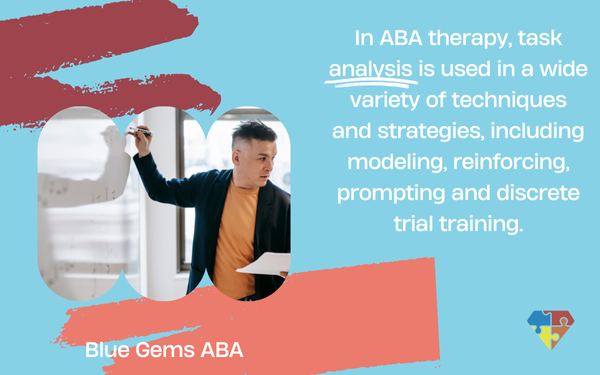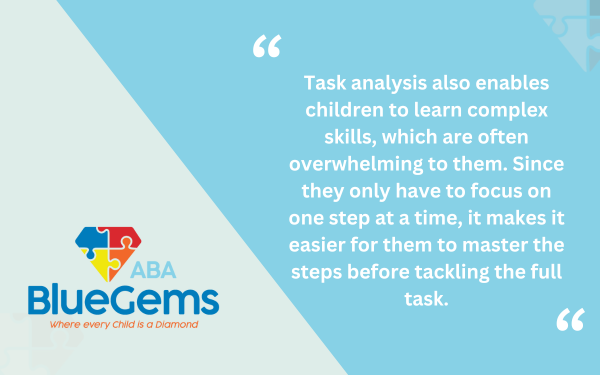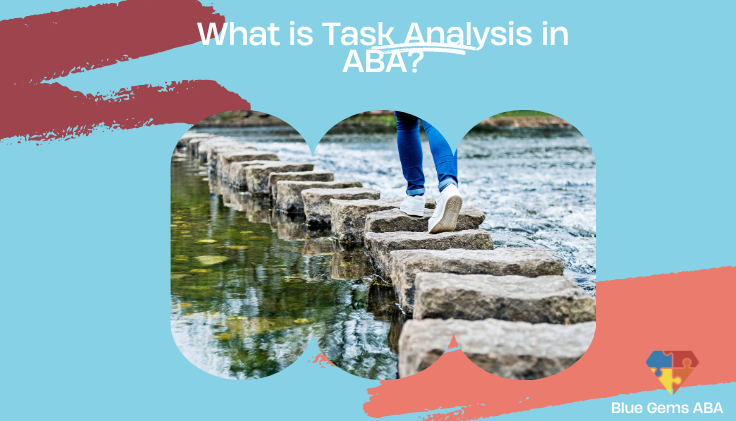What is Task Analysis in ABA?
Children with autism spectrum disorder (ASD) often struggle with communication and social interactions. They may have trouble completing daily life tasks and face challenges with sensory sensitivities.
As a result, many children with autism throw tantrums and engage in other negative behaviors, some of which could be harmful to themselves or others.
These challenges are only exacerbated by the fact that children on the autism spectrum commonly have trouble processing information in the same way that their neurotypical peers do. This could make it hard, for example, for them to learn new skills or modify their behaviors and actions by following traditional teaching strategies.
This is why applied behavior analysis (ABA therapy) integrates tasks analysis as a crucial teaching tool and treatment strategy for children with autism.
In this article, we’ll discuss what task analysis is, how it’s used in ABA therapy and why it’s useful.
Table Of Contents
What is Task Analysis?
Task analysis is an effective strategy for teaching children with autism new skills or behaviors. Instead of teaching these skills as one complete and complex task, ABA therapists break down the tasks into smaller steps that are much more manageable and easily understood by children with ASD.
These can be viewed as individual steps or sub-tasks, which, when mastered and carried out in a specific sequence, results in the child mastering the skill. What task analysis does is allow children to remain focused on smaller steps, which leads to them being less frustrated and anxious with the process, in turn making them more successful at acquiring necessary skills.
In ABA therapy, task analysis is used in a wide variety of techniques and strategies, including modeling, reinforcing, prompting and discrete trial training. It doesn’t matter where it’s being implemented, task analysis will always involve breaking down tasks into separate, smaller components.

How Does Task Analysis Work?
There are three ways in which task analysis can be implemented in ABA therapy.
The first, called forward chaining, is the most logical approach. It involves teaching children each step in sequential order, beginning with the first step and progressing step-by-step until the final step.
Backward chaining, by contrast, is the exact opposite. Children are led through the sequence of learning skills by starting with the last step and working backward.
Finally, total task teaching involves breaking down only the steps in a sequence that are causing problems for the individual child.
The approach that’s used should depend on the challenges, strengths and preferences of each individual child. This conclusion can only be made after a full evaluation is done for the child to see where they’re at with certain skills and whether they possess the abilities to be taken through task analysis for a particular skill.
| Approach | Description | Use Case |
|---|---|---|
| Forward Chaining | Teach the first step first, then move forward | For children who can begin a task but lose focus later |
| Backward Chaining | Teach the last step first, then work backward | For reinforcing success (child always completes the task) |
| Total Task Teaching | Teach all steps, focusing only on problem areas | For children with scattered strengths/needs |
What is an Example of Task Analysis?
A great way to understand task analysis is to look at an example, which in this case will be getting dressed.
To use task analysis to teach a child with autism to get dressed, therapists will break it down into individual steps, including:
- Finding the clothes (underwear, shirt, pants, socks)
- Opening the drawers where the clothes are located and taking the clothes out
- Taking off the clothes they have on (piece by piece)
- Picking up the underwear and putting it on
- Picking up the pants and putting them on
- Picking up the shirt and putting it on
- Putting the socks on
There are seven separate steps in our example here, but that can be increased or decreased depending on the child’s individual needs.
| Step | Description |
|---|---|
| 1 | Find clothes (underwear, shirt, pants, socks) |
| 2 | Open drawer and take out clothes |
| 3 | Remove current clothes |
| 4 | Put on underwear |
| 5 | Put on pants |
| 6 | Put on shirt |
| 7 | Put on socks |
What Are the Benefits of Task Analysis?
Through task analysis, ABA therapists can help support their patients more effectively.
It provides clear instructions that are very specific, which helps children understand exactly what’s expected of them. It’s very individualized, in that the steps can be catered specifically to each patient’s unique needs.
Task analysis also enables children to learn complex skills, which are often overwhelming to them. Since they only have to focus on one step at a time, it makes it easier for them to master the steps before tackling the full task.

Finally, task analysis makes it easier for therapists to collect data, which they’ll then analyze later to observe how the child is progressing toward their goals.
Blue Gems ABA Uses Task Analysis to Teach Children with ASD New Skills
Task analysis is a great tool and strategy that is used in ABA therapy to make it easier for children with autism to learn new skills and modify behaviors. By focusing on individual steps rather than complex tasks, children can learn more effectively without the feelings of being overwhelmed or anxious.
At Blue Gems ABA, we integrate task analysis into our ABA therapy treatment plans based on each patient’s individual strengths, challenges and preferences. This helps us to support the children we serve more effectively and efficiently.
To learn more, please contact us today.




